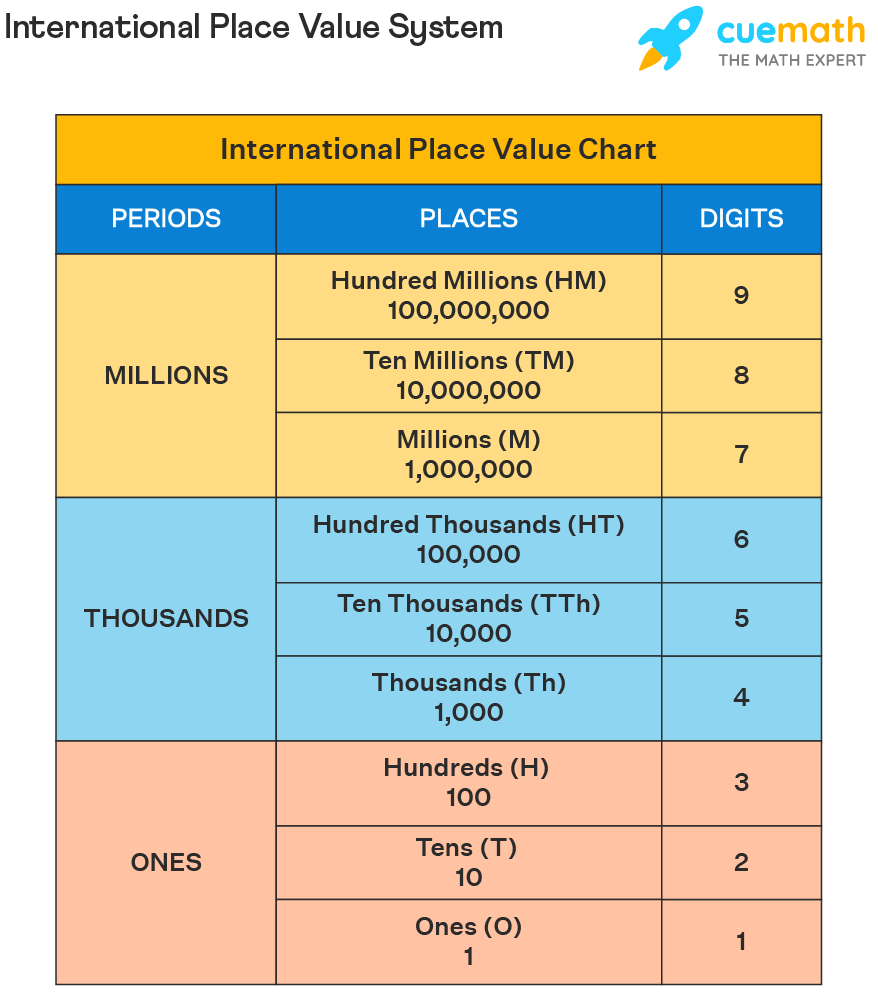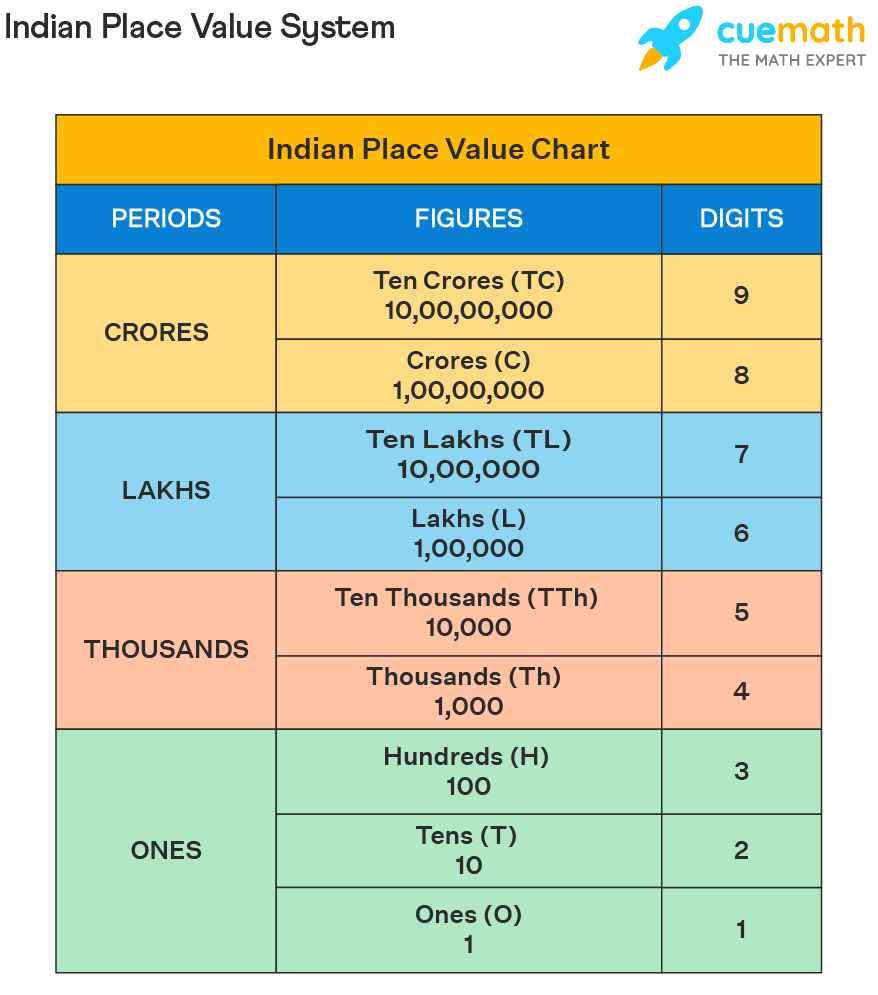International Place Value Chart
The International place value chart reads the value of a digit in a number according to the International place value system. In Mathematics, place value is the numerical value that a digit gets by virtue of its position in a given number. Place value charts are used to identify the correct position of all the digits in a number. There are two most commonly used place value charts - the Indian place value chart and the International place value chart.
| 1. | What is the International Place Value Chart? |
| 2. | Difference Between Indian and International Place Value Chart |
| 3. | FAQs on International Place Value Chart |
What is the International Place Value Chart?
The International place value chart is a table that is used to identify the value of each digit in a number based on its position, as per the International number system. In a place value chart, each digit has its own value which depends on its position. In order to make the process easier, the larger numbers are divided into periods that are separated with the help of commas. Observe the following International place value chart which is used to read and write numbers correctly according to their place values.

The International place value chart given above shows us the following observations related to the International place value system:
- The nine places are grouped into three periods: Ones, Thousands, and Millions.
- The numbers are separated by a comma after every three digits, starting from the right end.
- The first period is named ones, which consists of three place values: ones, tens, and hundreds.
- The second period is named thousands, which again consists of three place values: thousands, ten thousands, and hundred thousands.
- The third period is named millions, which also consists of three place values: million, ten million, and hundred million.
Difference Between Indian and International Place Value Chart
The major difference between the Indian place value system and the International place value system is seen in the placement of commas and in the periods in which they are categorized. Before studying more about their difference, let us know about the Indian place value system with the help of the following figure.

After observing the Indian place value chart, we can note the following features of the Indian place value system.
- The nine places are grouped into four periods: ones, thousands, lakhs, and crores.
- Starting from the right end, the numbers are separated by a comma according to the 3:2:2 system. This means the first comma is placed after 3 digits, and the following commas are placed after every 2 digits.
- The first period is named ones, which consists of three place values: ones, tens, and hundreds.
- The second period is named thousands, which consists of two place values: thousands and ten thousands.
- The third period is named lakhs, which consists of two place values: lakhs and ten lakhs.
- The fourth period is named crores, which consists of two place values: crore and ten crore.
Now, let us observe the following table that highlights the difference between the Indian and the International place value chart.
| Indian Place Value Chart | International Place Value Chart |
|---|---|
| Nine places are grouped into four periods: ones, thousands, lakhs, and crores. | Nine places are grouped into three periods: ones, thousands, and millions. |
| Place Values: Ones, tens, hundreds, thousands, ten thousands, lakhs, ten lakhs, crores, and ten crores. | Place Values: Ones, tens, hundreds, thousands, ten thousands, hundred thousands, million, ten million, and hundred million. |
| It follows the 3:2:2 system of placing commas. In other words, the first comma is placed after three digits from the right, and the next commas are placed after every two digits. For example, observe the commas in the smallest ten-digit number 1,00,00,00,000 according to the Indian place value system. | It follows the 3:3:3 system of placing commas. This means that starting from the right end, the numbers in all the periods are separated by a comma after every three digits. For example, observe the commas in the smallest ten-digit number 1,000,000,000 as per the International place value system. |
Important Notes
Observe the following numbers which are read by different names as per the Indian and the International place value system.
- One lakh in the Indian place value system is read as one hundred thousand in the International place value system. (1,00,000 = 100,000)
- Ten lakh in the Indian place value system is read as one million in the International place value system. (10,00,000 = 1,000,000)
- One crore in the Indian place value system is read as ten million in the International place value system. (1,00,00,000 = 10,000,000)
- Ten crore in the Indian place value system is read as one hundred million in the International place value system. (10,00,00,000 = 100,000,000)
- One arab (hundred crore) in the Indian place value system is read as one billion in the International place value system. (1,00,00,00,000 = 1,000,000,000)
Related links:
Check out the following pages related to the International place value chart.
Solved Examples
-
Example 1: Place the commas and write the number name of 2467543 according to the International place value system.
Solution:
Let us first write the number according to the International place value chart.

The number 2467543 is arranged in three periods according to the International place value chart, i.e., ones, thousands, and millions. The commas will be placed after every 3 numbers starting from the right end. Hence, the number will be written as 2,467,543 and it will be read as two million, four hundred sixty-seven thousand, five hundred forty-three.
-
Example 2:
a.) What is the place value of 3 in 846347 according to the Indian place value system and the International place value system?
b.) How will you read the given number according to the Indian place value system and the International place value system?
Solution:
a.) First, let us write the number as per the Indian place value chart.

Since 3 is in the hundreds place, the place value of 3 is (3 × 100) = 300
Now, let us write the number as per the International place value chart.

Since 3 is in the hundreds place, the place value of 3 is (3 × 100) = 300
b.) According to the Indian place value system, the number 8,46,347 is read as eight lakh, forty-six thousand, three hundred forty-seven. As per the International place value system, the same number 846,347 is read as eight hundred forty-six thousand, three hundred forty-seven.

FAQs on International Place Value Chart
What is the International Place Value Chart?
The International place value chart is a table that is used to identify the value of each digit in a number based on its position, as per the International number system. The place values that are used in this system are, ones, tens, hundreds, thousands, ten thousands, hundred thousands, million, ten million, hundred million, billion, and so on. All these places are grouped into the following periods: Ones, Thousands, and Millions, Billions, and so on. It follows the 3:3:3 system of placing commas. This means that starting from the right end, the numbers are separated by a comma after every three digits.
How to Write Numbers in the International Place Value System?
According to the International place value system, the numbers are separated by commas to split them into periods of ones, thousands, millions, billions, and so on. Starting from the right end, the numbers in all the periods are separated by a comma after every three digits. For example, 65424897 is written as 65,424,897 as per the International place value system and it is read as sixty-five million, four hundred twenty-four thousand, eight hundred and ninety-seven.
How to Make the International Place Value Chart?
In order to make an International place value chart that displays three periods, we need to draw 3 columns showing the 3 periods: ones, thousands, and millions. Then, under each period, we need to draw sub-columns to show the different place values. The first period which is named ones should have three place values: ones, tens, and hundreds. The second period which is named thousands should also have three place values: thousands, ten thousands, and hundred thousands. The third period which is named millions should again have three place values: millions, ten millions, and hundred millions.
What is a Place Value Chart?
A place value chart is a table that helps us to identify the place value of the digits in numbers. For example, let us find the place value of 5 in the number 6852. We know that 5 comes in the tens place according to the place value chart. Therefore, the place value of 5 is 5 × 10 = 50. Now, if we need to find the place value of 6 in the given number, it will be 6 × 1000 = 6000, because 6 comes in the thousands place according to the place value chart. There are two place value charts that are mainly followed - the Indian place value chart and the International place value chart.
How many Periods are there in the International Place Value Chart?
In the International place value chart, if we talk about a nine-digit number, then it will have 3 periods - ones, thousands, and millions. Starting from the right-hand side, the periods are named as ones, thousands, millions, billions, and so on. It should be noted that each period has 3 place values in it. For example, the first period which is named ones has three place values: ones, tens, and hundreds. The second period which is named thousands has three place values: thousands, ten thousands, and hundred thousands. The third period which is named millions also has three place values: million, ten millions, and hundred millions.
How do you Write Numbers in Words According to the International Place Value System?
When numbers are expressed in the form of words, we call them number names. According to the International place value chart, these number names depend on the different place values of the digits in the number. For example, the number name for 76,219,753 is expressed as seventy-six million, two hundred nineteen thousand, seven hundred fifty-three.
What is the Major Difference between the Indian and International Place Value System?
The main differences between the Indian and the International place value system are given below.
- According to the Indian place value chart, nine places are grouped into four periods: ones, thousands, lakhs, and crores. Whereas, as per the International place value chart, nine places are grouped into three periods: ones, thousands, and millions.
- In the Indian place value chart, place values are marked as ones, tens, hundreds, thousands, ten thousand, lakhs, ten lakhs, crores, and ten crores. While, in the International place value chart, place values are marked as ones, tens, hundreds, thousands, ten thousands, hundred thousands, millions, ten millions, hundred millions, and so on.
- The Indian place value chart follows the 3:2:2 system of placing commas. In other words, the first comma is placed after three digits from the right after the hundreds place value, and the next commas are placed after every two digits. For example, the number 3245743 is written as 32,45,743 in the Indian place value system. Whereas, the International place value chart follows the 3:3:3 system of placing commas. This means that starting from the right end, the numbers in all the periods are separated by a comma after every three digits. For example, observe the commas in the same number 3245743 which is written as 3,245,743 as per the International place value system.
visual curriculum
